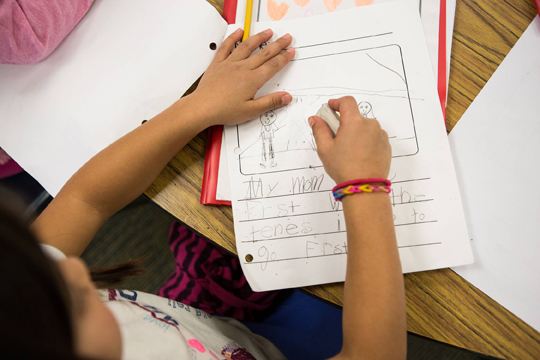Language Arts

At the center of the elementary campus Language Arts program is the essential question—What types of readers and writers do we want to cultivate and support? The answers to that question inform our mission-aligned, student-centered, and developmentally-appropriate curricular and pedagogical approaches. Our multifaceted and integrative system of instruction focuses squarely on the needs of the students and begins with assessment. Teachers regularly and systematically gather and examine information about their students to determine the instructional direction; in other words, What do my students know? How do I move them forward?
Readers and Writers Workshops create a space for students to participate in authentic, meaning-based experiences in tandem with instruction on the formal features of language (phonics, spelling, and grammar). At the same time, this organizational structure allows teachers to choose from a menu of teaching practices that continually shift the balance between teacher and student control—the ultimate goal being student independence. It also provides for the flexibility of multiple, differentiated grouping opportunities (whole class, small group, and individual conferences) and instruction that honors both the planned lesson and the spontaneous “teachable moment.” Connecting reading and writing instruction supports our belief that “readers learn about writing from reading while writers learn about reading from writing.”
The Language Arts curriculum is composed of units of study. Each is framed by a “big idea” that provides a vision and focus for teaching objectives, thereby ensuring the depth of program quality and effectiveness. The “big ideas” reflect understandings that students need in such areas as the specifics of the reading and writing processes, the elements and themes of literature, reading and writing genres, author studies, and themes related to social justice, diversity, equity, and inclusion.
Similar Big Ideas exist throughout our K-6 classes. The developmental differences from grade-to-grade dictate the complexity of the texts, the themes encountered, and the types of strategies to which students are exposed. In K-1, a key focus is on learning to read through guided reading groups tailored to each child’s instructional level and small-group word study work that supports both reading and writing development. In grades 2-3, the focus becomes using language to learn, such as exploring the ways in which authors can highlight social justice issues through literature. Students in grades 4-6 experience levels of instruction that deepen their reading and writing skills through more sophisticated processes and content matter. Instruction in these grades includes the exploration of texts that present multiple perspectives of complex historical moments and promote inferential thinking.